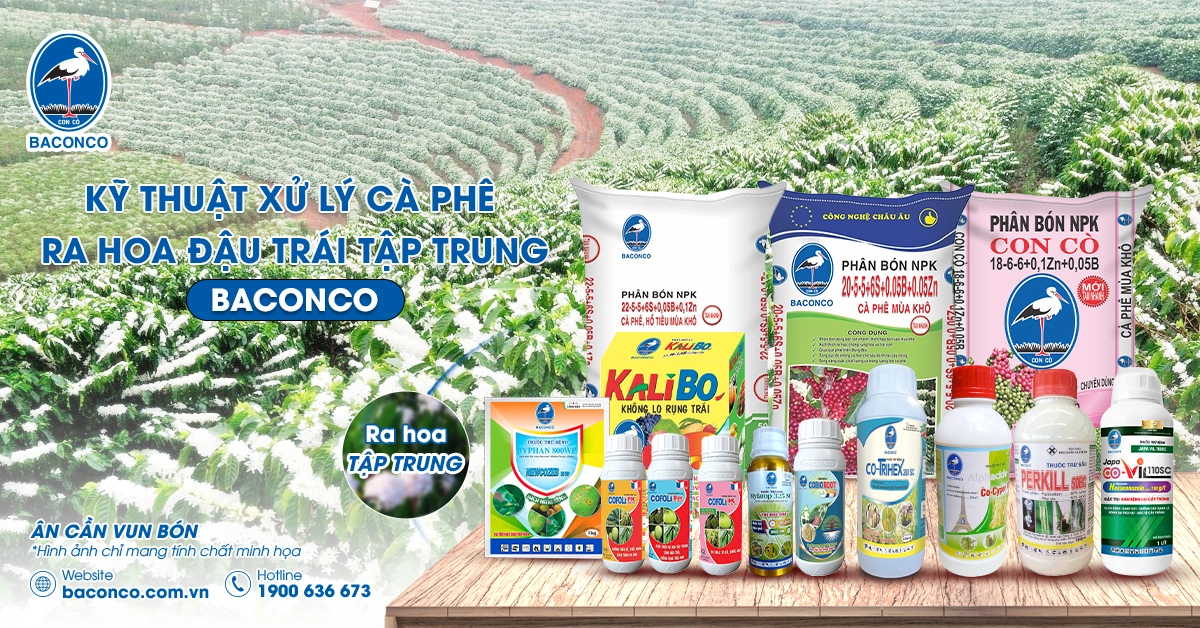Detailed Guide On Techniques For Inducing Simultaneous Flowering In Coffee Plants
03 Feb 2025

A detailed guide on techniques for inducing simultaneous flowering in coffee plants, covering steps from preparation, spraying for bud formation, to post-fruit set care, aimed at increasing productivity and optimizing economic efficiency for farmers.
The Importance Of Inducing Flowering In Coffee
Coffee is a unique crop, and the flowering process is heavily influenced by the environment and care practices. Normally, after a dry period when it rains or is watered, the plant will flower.
However, relying solely on natural conditions can lead to uneven flowering, which negatively impacts both yield and quality. Common issues include:
- Scattered flowering: Difficulties in pollination, resulting in low fruit set rates.
- Reduced yield: Fewer flowers, leading to insufficient quantity and quality of fruit.
- Challenges in pest and disease control: Non-concentrated flowering increases care costs.
- Adverse weather conditions: Prolonged rain or sun can cause flower and young fruit drop.
- Increased costs: It takes effort and time to deal with uneven blooming flowers.
Inducing flowering ensures that flowers bloom simultaneously and develop consistently on the plant. Image: Internet
Things to Note Before Flower Induction
To achieve the best results in the flower induction process, farmers should pay special attention to the following factors:
1. Age and growth condition of the plant:
- Plant Age: Coffee plants need to be at least 2-3 years old to be capable of flowering and bearing fruit.
- Plant Condition: The plant must be healthy, and have sufficient accumulated nutrients to flower and support fruit development.
2. Weather factors:
- Temperature: The ideal temperature for coffee flowering is between 19-24°C. Temperatures that are too high or too low can affect pollination.
- Humidity: Maintain moderate soil moisture, avoiding conditions that are too dry or too wet.
- Light: Sufficient light is necessary for photosynthesis, which generates energy for flowering.
3. Soil conditions:
- Garden Hygiene: Remove weeds and plant debris to prevent nutrient competition and limit pests and diseases.
- Soil Aeration: Tilling the soil helps create aeration, allowing the roots to develop well.
4. Fertilizer management:
- Coffee plants have different nutritional needs at each growth stage (flower bud differentiation, flowering, fruit set, and fruit development).
- Applying fertilizer at the right stage ensures the plant receives appropriate nutrients, avoiding excess or deficiency, and ensuring optimal growth.
5. Pest and disease control:
- Pests and diseases are the main causes of weakened coffee plants, leading to reduced yield and quality of beans. Applying pest and disease prevention measures helps protect plants from the risk of infection.
- Healthy plants will concentrate energy on flowering, fruit setting, and fruit development, resulting in higher yields and better quality coffee beans.
Concentrated Coffee Flower Induction Techniques
During coffee cultivation, the dry season is a critical period for flowering. However, erratic drought or unseasonal rain can disrupt the process of flower bud differentiation, making it difficult to water the flowers to bloom concentratedly.
To assist in concentrated coffee flowering, BACONCO introduces the following technical process:
Managing flowering on coffee trees helps achieve high-quality coffee beans. Image: Internet
Step 1: Spray germination stimulant for coffee
- Mixture: 500ml CO-VIL 110SC (or CO-TRIHEX 280SC) + 450ml COFOLI K300 + 450ml COFOLI PK500 mixed with 200 liters of water.
- Effect: CO-VIL 110SC and CO-TRIHEX 280SC effectively prevent and treat fungi; when combined with COFOLI PK500 and COFOLI K300, they help concentrate flower bud differentiation.
Step 2: Spray to stimulate concentrated flowering
- Timing: After the first watering or when the flower buds are the size of rice grains.
- Mixture: 500g MANCOZEB GREEN HERONCON CO + 450ml COFOLI AMINO + 500mg KALIBO + 250ml COCYPER 100EC mixed with 200 liters of water.
- Effect: Prevents pests and diseases, promotes uniform flowering, prevents flower and fruit loss.
Step 3: Spray after the second watering or when the coffee has set fruit
- Mixture: 250ml MYFATOP 325SC + 250ml COFOLI BO + 250ml COBIOROOT + 250ml PERKILL mixed with 200 liters of water.
- Effect: Controls pests and diseases, prevents fruit drop, and stimulates roots to absorb nutrients for fruit development.
Additionally, farmers should continue to apply dry season fertilizers from BACONCO such as:
- NPK CON CO 20-5-5+6S+0.05B+0.05Zn
- NPK CON CO 22-5-5+6S+0.05B+0.1Zn
- NPK CON CO 18-6-6+0.1Zn+0.05B
Dosage: 250kg/ha, helps trees recover after harvest, flower, set strong fruit and prevent young fruit from falling.
The management of concentrated flowering in coffee trees must be carried out correctly in terms of technique and timing to save costs, ensure maximum effectiveness, and increase the yield and quality of coffee beans. If farmers need assistance, please contact Baconco directly for prompt advice!
Views
1059
